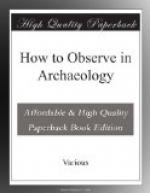I. PREHISTORIC (?) AGE: Chalcolithic (aeneolithic) period, before 3500 B.C.
Until quite recently no traces of the Stone Age had been discovered in Babylonia other than a few possible palaeoliths lying on the surface of the desert: all traces of a Neolithic Age were supposed to have been buried beneath the alluvium of the valley. In Assyria, however, neolithic traces in the shape of obsidian flakes had been discovered by the late Prof. L. W. King in the course of his excavation of the mound of Kuyunjik (NINEVEH), besides fragments of painted pottery resembling those from the earliest deposits in Asia Minor and those found by the American geologist Pumpelly in his diggings in the kurgans of Turkestan, (to which he assigned an extremely remote date B.C.). In Persia, and about the head of the Persian Gulf, somewhat similar pottery was discovered by de Morgan and the other French excavators at Susa, Tepe Musyan, Bandar Bushir, and other places: here again the dates were put at a very remote period. With the exception of a few flint saw-blades from Warka [1], Fara, Zurghul, and Babylon [2], no similar remains had been found in Babylonia until, in 1918, Capt. R. Campbell Thompson, exploring on behalf of the British Museum, discovered flint and obsidian flakes and painted pottery lying on the surface of the desert at Tell Abu Shahrein (ERIDU), and also at Tell Muqayyar (UR). The continued excavations carried out by Mr. H. R. Hall for the Museum in 1919 have produced more of the same evidence from both places, besides a new ‘prehistoric’ site at Tell el-Ma’abed or Tell el-’Obeid near Ur. It seems that these antiquities date from the very end of the neolithic, or rather to the succeeding ‘chalcolithic’, age; whether they are really prehistoric, as regards Babylonian history, must until more evidence from stratified deposits is found remain undecided. They prove the occupation of the head of the Persian Gulf at the beginning of history by a people whose primitive art was closely akin to that of early Elam, and distinct from that of the Sumerians.
[1] Found by Loftus in 1854: their early date was not recognized at the time. [2] Koldewey, Excavations at Babylon, E.T., p. 261, fig. 182. Koldewey curiously speaks of the saw-blades as ‘palaeolithic.’ They are, of course, nothing of the sort.
Characteristics: flint, chert, obsidian, green and red jasper, and quartz-crystal flakes, arrowheads, cores, and saw-blades. Chert and limestone rough hoe-blades (easily mistaken for palaeolithic implements; they are, however, much flatter); polished serpentine or jasper celts; lentoid (lentil-shaped), amygdaloid (almond-shaped), and discoid beads of cornelian, crystal, obsidian, &c., unpolished; nails of translucent quartz and obsidian (obviously imitations of metal types); hard grey pottery sickles, pottery cones of various sizes, and pottery objects like gigantic nails bent




